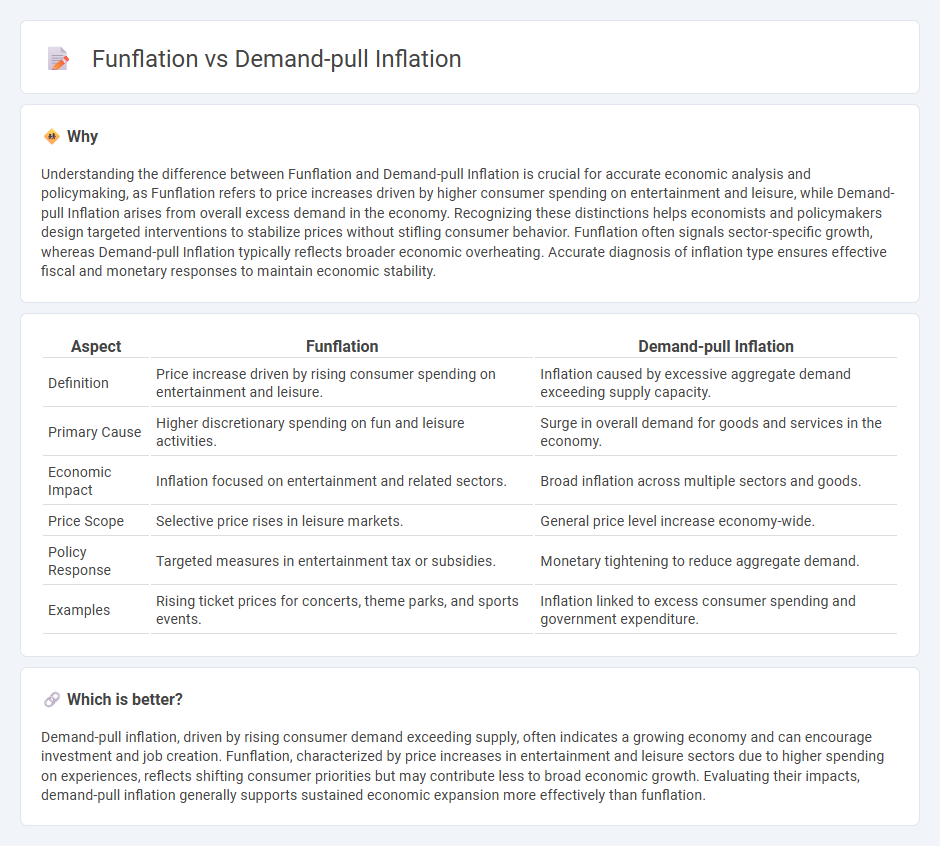
Funflation describes rising prices driven by increased consumer spending on entertainment and leisure activities, reflecting shifts in lifestyle preferences. Demand-pull inflation occurs when aggregate demand surpasses supply, causing general price levels to rise across the economy. Explore the key differences and economic impacts of funflation versus demand-pull inflation to deepen your understanding.
Why it is important
Understanding the difference between Funflation and Demand-pull Inflation is crucial for accurate economic analysis and policymaking, as Funflation refers to price increases driven by higher consumer spending on entertainment and leisure, while Demand-pull Inflation arises from overall excess demand in the economy. Recognizing these distinctions helps economists and policymakers design targeted interventions to stabilize prices without stifling consumer behavior. Funflation often signals sector-specific growth, whereas Demand-pull Inflation typically reflects broader economic overheating. Accurate diagnosis of inflation type ensures effective fiscal and monetary responses to maintain economic stability.
Comparison Table
| Aspect | Funflation | Demand-pull Inflation |
|---|---|---|
| Definition | Price increase driven by rising consumer spending on entertainment and leisure. | Inflation caused by excessive aggregate demand exceeding supply capacity. |
| Primary Cause | Higher discretionary spending on fun and leisure activities. | Surge in overall demand for goods and services in the economy. |
| Economic Impact | Inflation focused on entertainment and related sectors. | Broad inflation across multiple sectors and goods. |
| Price Scope | Selective price rises in leisure markets. | General price level increase economy-wide. |
| Policy Response | Targeted measures in entertainment tax or subsidies. | Monetary tightening to reduce aggregate demand. |
| Examples | Rising ticket prices for concerts, theme parks, and sports events. | Inflation linked to excess consumer spending and government expenditure. |
Which is better?
Demand-pull inflation, driven by rising consumer demand exceeding supply, often indicates a growing economy and can encourage investment and job creation. Funflation, characterized by price increases in entertainment and leisure sectors due to higher spending on experiences, reflects shifting consumer priorities but may contribute less to broad economic growth. Evaluating their impacts, demand-pull inflation generally supports sustained economic expansion more effectively than funflation.
Connection
Funflation, driven by increased consumer spending on entertainment and leisure activities, intensifies demand-pull inflation by boosting aggregate demand beyond supply capacity. This surge in consumer expenditure creates upward pressure on prices as businesses raise prices to balance heightened demand. The interplay between funflation and demand-pull inflation underscores the impact of evolving consumption patterns on overall economic inflation dynamics.
Key Terms
Aggregate Demand
Demand-pull inflation occurs when aggregate demand in an economy outpaces aggregate supply, leading to higher prices as consumers compete for limited goods and services. Funflation, a term describing price hikes driven by increased spending on entertainment and leisure rather than essential goods, reflects shifts in consumer preferences impacting aggregate demand in specific sectors. Explore the dynamics of aggregate demand to understand how these inflation types influence economic policy and market behavior.
Consumer Spending
Demand-pull inflation occurs when rising consumer spending outpaces supply, causing prices to increase due to heightened demand for goods and services. Funflation reflects price hikes in leisure and entertainment sectors, driven by increased consumer willingness to spend on experiences rather than essentials. Explore deeper insights into how shifting spending patterns influence inflationary trends.
Entertainment Industry
Demand-pull inflation in the entertainment industry occurs when increased consumer spending drives up ticket prices, streaming subscriptions, and merchandise costs, reflecting heightened demand outpacing supply. Funflation, a term describing deliberate price hikes justified by added value or enhanced experiences, emerges as companies bundle services or introduce premium content to offset rising operational expenses. Explore the nuances between these economic trends and their impact on your entertainment choices.
Source and External Links
Demand-Pull Inflation: How Does It Work? - SmartAsset - Demand-pull inflation occurs when demand for goods and services outpaces supply during strong economic growth, causing prices to rise as more money chases limited goods, often fueled by government spending, consumer confidence, and monetary policy.
Causes of Inflation | Explainer | Education | RBA - Demand-pull inflation happens when aggregate demand exceeds aggregate supply, pushing prices higher as firms raise prices and wages due to increased demand for labor and goods, creating a cycle of rising prices and wages across the economy.
Demand-pull inflation - Wikipedia - Demand-pull inflation is caused by aggregate demand exceeding aggregate supply when the economy is near full employment, leading to rising inflation as real GDP grows and unemployment falls, described as "too much money spent chasing too few goods".
 dowidth.com
dowidth.com